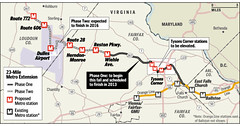Protesting transportation "planning"... (Bicycle protest, San Francisco)
DC1974 points us to a protest in SF, as written up in SFist. See "Bike Plan Injunction Injunction, What's Your Function?." (Photo from DCist)
Last week at a presentation I made some negative comments about the DC Comp Plan. Afterwards I spoke with a person who was intimately involved with that process, who "challenged" me.
I responded that there's almost nothing in the Comp Plan about "parking and curbside management", that land use and transportation planning need to be integrated, i.e., DDOT planners should be up on the dais during Zoning Commission and Board of Zoning Adjustment matters (meaning that DDOT transportation demand management planning should be part of ZC and BZA matters with equal footing), that DC doesn't really have a transportation "plan" and that was reflected in the weakness of the Transit Element of the Comp Plan.
And don't get me started on the failure to mandate Transportation Demand Management.
During the process I specifically challenged some smart growthers who should have known better, about their positive testimonies about the Comp Plan, when the Comp Plan draft and now final version had almost nothing substantive about transportation demand management--it suggested TDM could be used with Planned Unit Development projects (my joke is that my testimonies on this particular point changed one word of the Comp Plan, from "may" to "shall" in this sentence)--but did not mandate TDM as a transportation priority, based on some specific principles starting with this one: substantive reduction of single occupancy vehicle trips.
Well, this person conceded my points, stating that the then DDOT director wasn't interested in integrating transportation planning into the Comprehensive Plan process.
(Note that this relates to my point about a Planning Commission needing to have oversight over all planning activities in the city, not just those conducted by the land use focused Office of Planning.)
We have a long way to go in terms of linking land use and transportation planning in the city, despite all the talk of transit oriented development.
Washcycle runs a "Christmas Wish List" feature every year about desired improvements in the bicycling environment and infrastructure.
On January 1st, I wrote a "looking back at 2006" piece.
I am not sure I have the same kind of overview perspective after working as a Main Street manager this year, if I can write some sort of overview of the year in the same way (we'll see I suppose on January 1st).
Still, there are three things I hope to pursue next year:
1. I am going to start attending Sierra Club DC Transportation Committee meetings starting in January (1st Tuesday of the month).
2. We need to develop a "People's Transportation Plan for DC"
3. We need to launch a first go of a regional transportation/transit advocates conference.
The Transbay blog has a magisterial analysis of the proposed Central Subway in San Francisco. I don't know SF at all, so I can't really comment on it.
(But SF has a light rail system in terms of speed and capacity of the transit vehicles, it's not a heavy rail system comparable to that of NYC or DC, despite the fact that some of the system is underground. The BART is a heavy rail system.)
But it reminds me that from the standpoint of overall transportation planning and impact in the DC region, likely the Silver Line subway extension isn't the most important investment that could be made right now in terms of improving the reach and impact of the subway "system."
But because transportation "planning" for WMATA has devolved to the individual jurisdictions, the overall planning function has been derogated.
But transportation advocates haven't produced the equivalent analysis of the Silver Line extension comparable to that by Transbay of the Central Subway proposal.
Most smart growth types favor the Silver Line because it can begin the process of promoting more compact development in Fairfax and Loudoun Counties.
But from the Belmont perspective, it would merely add to sprawl, because it's an extension to an already polycentric transit system that doesn't focus on compact development and reducing automobile trips overall.
For agreeing to extending the Metro out to Loudoun, in turn there should be an agreement to intensify and extend service capabilities within the current system. This did not happen.
The proposal for a separated blue line to add service capability within the center city, and another tunnel across the Potomac River, to add capacity and redundancy between VA and DC, was dropped in 2003.
For whatever reason, the Silver Line extension planning has been allowed to go forward without having to address tunnel capacity issues between VA and DC. This capacity constraint already limits service on the blue and orange lines.
Labels: transportation planning




0 Comments:
Post a Comment
<< Home